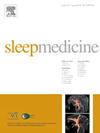What helps and what hurts adolescents’ sleep? An intense longitudinal ecological momentary assessment of daily facilitators and barriers of sleep on school and non-school nights
IF 3.8
2区 医学
Q1 CLINICAL NEUROLOGY
引用次数: 0
Abstract
Objective
Using an intense longitudinal design, we investigated adolescents’ perceptions of everyday factors facilitating (i.e., facilitators) and hindering (i.e., barriers) sufficient and good quality sleep.
Method
Adolescents (N = 205, Mage = 16.9 ± 0.9, 54.1 % female, 64.4 % non-white) completed daily morning surveys, assessing self-reported sleep and the use of 8 facilitators and 6 barriers of sleep from the previous night, and wore actigraphs over 2 school-weeks followed by 2 vacation-weeks (5162 total observations). Linear mixed-effects models examined the contribution of facilitators/barriers to actigraphy and self-reported total sleep time (TST) and sleep onset latency (SOL), controlling for age, sex, race, and study day. School/non-school day status was included as a moderator.
Results
Seven facilitators and two barriers were reported by >30 % of adolescents as frequently (≥50 % nights) helping/preventing them from achieving good sleep. Facilitators or barriers explained 1–5% (p-values <.001) of unique variance above and beyond the covariates. Facilitators that predicted better sleep were: following body cues, managing thoughts and emotions, creating good sleep environment, avoiding activities interfering with sleep, and bedtime planning (only TST on school nights). Barriers that predicted worse sleep were: pre-bed thoughts and emotions, unconducive sleep environment, activities interfering with sleep, inconsistent routines, and other household members’ activities.
Conclusion
Adolescents use a range of sleep-facilitating behaviours, and a number of factors prevent sufficient and good quality sleep in their everyday life. These factors are predictive of their sleep duration and onset latency and require further research to understand their functions and clinical implications.
求助全文
约1分钟内获得全文
求助全文
来源期刊

Sleep medicine
医学-临床神经学
CiteScore
8.40
自引率
6.20%
发文量
1060
审稿时长
49 days
期刊介绍:
Sleep Medicine aims to be a journal no one involved in clinical sleep medicine can do without.
A journal primarily focussing on the human aspects of sleep, integrating the various disciplines that are involved in sleep medicine: neurology, clinical neurophysiology, internal medicine (particularly pulmonology and cardiology), psychology, psychiatry, sleep technology, pediatrics, neurosurgery, otorhinolaryngology, and dentistry.
The journal publishes the following types of articles: Reviews (also intended as a way to bridge the gap between basic sleep research and clinical relevance); Original Research Articles; Full-length articles; Brief communications; Controversies; Case reports; Letters to the Editor; Journal search and commentaries; Book reviews; Meeting announcements; Listing of relevant organisations plus web sites.
 求助内容:
求助内容: 应助结果提醒方式:
应助结果提醒方式:


